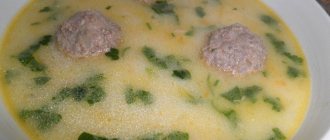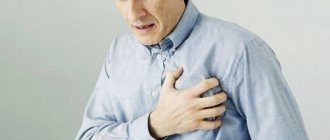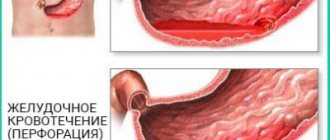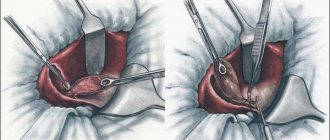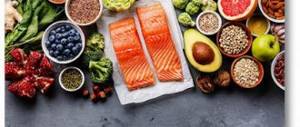About the operation
Removal of the stomach is a difficult surgical operation, which is prescribed when there are no other ways to save a person’s life. It's called a gastrectomy. In this case, this organ is completely removed. Even if the operation was successful and there were no serious complications, the patient needs to prepare for long-term rehabilitation. If the stomach is completely removed, it is important to take vitamins in the form of medications, especially vitamin B12, since it is absorbed in the stomach, and without additional treatment, pernicious anemia can develop.
However, the prognosis is favorable if the patient underwent surgery on time, and then underwent rehabilitation and followed all the doctor’s recommendations. You can easily adapt to new digestive conditions. But with oncology, everything is much more complicated, since much depends on the stage of cancer and the general condition of the patient.
Gastric resection is a similar operation, however, the patient does not have the entire organ removed, but only part of it: from a quarter to 2/3. Then the stump of the stomach is connected to the duodenum. This is also a serious operation, like removing the stomach. To recover from it, you need to strictly follow the doctor’s recommendations, it is especially important to eat right.
Diet goals
Proper nutrition after gastric resection promotes faster recovery of the body and prevents the development of complications. The main goal of the diet is to speed up the healing process of the remaining part of the organ, since regular food can only lead to a worsening of the condition. The menu, recipes, and foods that can be consumed are selected exclusively by a gastroenterologist.
Since after surgery the patient quickly loses weight, another goal of dietary nutrition is to maintain his weight at a normal level and prevent exhaustion of the body.
In addition, after removal of the stomach, the anatomy of the digestive organ completely changes, which also leads to the emergence of other conditions that facilitate the digestion of incoming food. A recovery diet is aimed at ensuring that the human body adapts to a new state and begins to function normally.
Nutrition in the first days
Immediately after gastric surgery, the patient cannot eat, so there is no need to bring anything to the hospital. For the first 2 days he fasts, and on the third day the doctor may allow him to drink a little compote or rosehip decoction, or sweet tea. The patient is given water every 15 minutes, giving him 1 tsp. liquids. There is something that doctors do not recommend immediately after surgery; feeding the patient is organized by the medical staff of the clinic. To ensure that the body receives all the necessary nutrients, special mixtures of proteins and amino acids can be administered intravenously. The doctor may also prescribe protein enpit. The patient receives 30-50 ml of this solution. First, it is administered through a probe, then, when it is removed, through the mouth. The patient eats in this peculiar way for about 2 or 3 days. Gradually the amount of protein enpitite obtained is increased.
Nutrition before surgery
It should be noted that not only after surgery you need to switch to a healthy diet. For gastric removal to be successful, the patient is advised to go on a diet that will prepare the body (this will make it easier for him to withstand the upcoming stress).
A few days before surgery, the following meals are recommended:
- Eating foods high in protein and fiber.
- Soda, sweet juices and alcoholic drinks are prohibited
- You will need to exclude from the diet light carbohydrates, which the body mainly receives from sweets (buns, pastries, pies and other confectionery products). It is recommended to replace this type of food with complex carbohydrates (porridge and some vegetables).
Well, for those who have a sweet tooth, in addition to fruits, there are many alternatives, for example, for breakfast you can make oatmeal with a teaspoon of honey and berries, and for dinner - curd pudding. Such desserts should be consumed before surgery, as they saturate the body with strength and energy.
Information about squamous cell carcinoma of the stomach: symptoms and treatment. Features of the infiltrative form of stomach cancer are described in this article.
Here https://stoprak.info/vidy/zhkt-kishechnik/zheludok/trinadcat-prichin-kotorym-podverzhen-kazhdyj.html causes of stomach cancer in men are listed.
Nutrition after surgery
After 4 or 5 days, the doctor will switch the patient to a normal diet, provided that he has no bloating and normal peristalsis. But this does not mean that now he will be able to eat dumplings with sour cream or pies. The diet after surgery is very strict, but it cannot be violated, since proper nutrition is an important part of the patient’s rehabilitation.
After gastrectomy, the patient must eat according to a special diet. There are several types of diet that are prescribed to the patient. You need to adhere to each of them for about 2-4 days, but the doctor can increase or shorten this period, it depends on the patient’s well-being.
Diet No. 0A
Diet No. 0A is prescribed on days 4 or 5.
Features of this diet: little salt (no more than 1 or 2 g) and a lot of water (1.8 -2.2 l). The patient should eat at least 7 or 8 times a day, eating no more than 250 g of food. As an addition to the diet, you are allowed to eat 1 or 2 soft-boiled eggs. What you can eat:
- mucous decoctions to which cream is added;
- light meat broth, no fat;
- fruit or berry jelly;
- juices from vegetables or fruits;
- sweetened drink made from rose hips.
For now, you cannot eat dense foods, even if they are pureed, or drink milk.
Diet No. 0B
This diet is needed on the 6th or 8th day after surgery due to stomach cancer. The patient should take up to 2 liters of liquid, and the amount of salt is slightly increased, up to 4 or 5 g. The patient can eat up to 6 times a day, servings - 400 g each. What is possible? The menu is the same as for diet No. 0A, but the list of allowed products is longer:
- soups with cereals;
- the patient can already eat pureed porridges made from rice or buckwheat, but only if they are liquid;
- soft-boiled eggs or white omelet are allowed;
- The patient’s menu also includes meat and fish (puree), but only dietary ones.
Diet No. 0B
This diet is usually prescribed for days 9-11. This is a special diet after surgery, when the patient switches to a full diet. The patient should drink up to 1.5 liters of water or other liquid, the amount of salt allowed is 6 or 7 g. The patient eats about 5 or 6 times a day, the following dishes are added to his menu:
- cream soup;
- white crackers, but not more than 75 g;
- pureed vegetables or fruits;
- apples, but not fresh, but baked;
- chopped meat or fish;
- cottage cheese, you can add a little cream;
- various fermented milk drinks.
Nutrition after removal of the stomach for cancer: what you can eat, menu after resection
Surprisingly, many people do not know that a person can live without a stomach.
The body is able to do without an organ designed for storing and primary processing of food. The anastomosis allows food to pass from the esophagus directly to the intestine. Naturally, nutrition after removal of the stomach for stomach cancer changes dramatically. Due to the inability to digest foods, metabolism is disrupted, which can lead to various complications.
Features of digestion in patients with a removed stomach
After a gastrectomy, the digestion process changes dramatically, so you need to carefully follow the recommendations of a nutritionist. It is important that the body still receives all the necessary nutrients.
After removal of the stomach, especially if the tumor has spread to the intestines, the patient may not feel hungry at all. Therefore, you should try to eat food while counting calories.
Of course, losing weight in the first few months after surgery is normal, but the patient’s main task is to prevent a pathological decrease in body mass index.
Even if there is no feeling of hunger, it is important to eat at least in order to have the strength to heal the operated areas.
Another feature of digestion is the deterioration of the absorption of certain vitamins: the lack of vitamin B12 is especially acute. The fact is that the stomach produces a protein that allows the intestines to absorb cobalamin. Therefore, patients who have had a total gastrectomy need to take B12 supplements or injections every few months.
Nutrition after gastric resection for cancer also needs to be organized taking into account the high risk of developing dumping syndrome. If swallowed food passes too quickly from the esophagus directly into the intestines, nausea, diarrhea, intense sweating and vomiting occur.
Basic diet rules
Nutrition after gastric resection for oncology must obey the strictest rules. After discharge home, it is recommended to switch to a “soft” diet of digestible foods.
You will have to eat smaller amounts of food, but more often: six to eight small portions per day. It is also recommended to remain upright for some time after finishing your meal.
Since the stomach can no longer process food, it is important to eat small pieces and chew even soft foods thoroughly. You should also try not to allow more than 2-3 hours between meals.
It's best to carry small snacks with you to fuel yourself anywhere.
In the first weeks after intranasal or parenteral nutrition is discontinued, the diet should consist only of liquid foods. Juices, fresh juices, and vegetable purees will provide the body with the necessary calories and nutrients, but at the same time will not irritate unhealed areas.
Another important advice from a nutritionist: you need to stop drinking food. Drinking water at the same time as eating results in less room for food. Instead, it is better to drink several glasses of pure water between meals.
Habitual and familiar foods to which there was no previous allergy may provoke intolerance after surgery. It is worth giving the body time to get used to each new product in the diet.
Permitted, fully or partially prohibited products
Nutrition after gastric surgery for oncology should be balanced. The basis of the diet should be protein-rich foods. It is protein that helps the body repair cells and tissues, and also helps the immune system recover after chemotherapy or radiotherapy.
Allowed protein sources:
- lean poultry;
- fish;
- eggs;
- yogurt, kefir.
Your diet should include whole grains: they provide the body with the right carbohydrates and fiber and help maintain energy levels. Optimal sources of whole grains:
- oat groats;
- brown rice;
- whole grain pastas.
You should also eat a variety of fruits and vegetables on a daily basis. Fruits and vegetables provide the body with antioxidants: the main defenders of healthy cells against cancer.
You can't give up healthy fat either. Fried, fatty and spicy foods should not be included in the diet. Instead, you should include in your diet:
- olives and olive oil;
- sesame, sesame oil;
- nut mixtures.
You should also limit the amount of sweets in your diet, especially processed sugar.
Sample nutrition menu after gastric resection
In fact, it is difficult to answer the question “how to eat after removal of the stomach,” because each patient’s body is unique. However, you can adhere to the general recommendations of nutritionists.
In the first week after stopping nasal feeding, you are allowed to drink only clear liquids. It is possible to comply with such a rule, but it is difficult.
If a feeling of hunger occurs, the patient can be “fed” through a tube.
It is very important to make sure that there is no sugar in the drink offered to the patient. The daily menu can be combined from the following dishes:
- vegetable or fish broth;
- green tea;
- dried fruits compote.
In the second week you can add more protein. Protein shakes are a great option. During the second week, a person may begin to feel psychologically hungry. The diet may consist of:
- protein powder diluted with still water without added sugar;
- broth with homemade noodles made from coarse whole grain flour;
- low-fat homemade yogurt without additives;
- pureed vegetable soups;
- oatmeal jelly;
- compote;
- applesauce.
In the third week after surgery, primary healing of the intestinal anastomosis is usually noted. The good news is that you can finally start adding solid foods to your diet, albeit pureed ones.
Sugars are still prohibited at this stage. It is necessary to ensure that the patient receives at least 60 g of protein per day. You also need to eat very slowly. New products should be introduced according to the following scheme: one product every day.
Approximate daily menu in the third week after gastrectomy
Breakfast:
- 100 grams of low-fat yogurt;
- protein shake with almond or coconut milk.
2nd breakfast:
- oatmeal jelly with skim milk
Dinner:
- vegetable puree soup;
- steamed white fish fillet (grind in a blender before use);
- dried fruits compote.
Afternoon snack:
- grated low-fat cottage cheese.
Dinner:
- steamed omelette.
Mashed bananas are also suitable as snacks.
Other products that can be included in the diet menu after gastric resection for oncology:
- rye cereals soaked in skim milk or kefir;
- vegetables, steamed or boiled until soft;
- soft varieties of low-fat cheeses;
- canned tuna and salmon in its own juice.
In the third week, sugar is still prohibited, as well as starchy foods (white flour pasta, rice and bread). Do not eat fibrous vegetables such as celery, broccoli, asparagus, lettuce, and greens.
You can learn how to eat after gastric resection for oncology from this video.
A sample menu that you will have to stick to for the rest of your life
The list of permitted products is quite extensive:
- red fish;
- steamed veal;
- bird;
- fruits;
- vegetables;
- grain products.
Coffee fans can start drinking chicory. If the body does not react negatively to the new drink, then after a few weeks it will be possible to introduce decaffeinated coffee into the diet (possibly with the addition of skim milk).
The following products are strictly prohibited:
- soda;
- any fried food;
- processed sugars;
- high-carbohydrate foods with low nutrient content (pizza, rolls, potatoes in large quantities).
Of course, you should not drink alcohol or eat snacks (crackers, chips, candy bars, etc.). Ignoring simple nutritional rules can lead to the development of ulcers of the esophagus and intestines.
Healthy snack options
Since nutritionists recommend that patients add 2-3 snacks in addition to three main meals, always have a tasty healthy snack on hand that does not require heating. Naturally, each dish should be added to the menu only after approval by a nutritionist.
Great snack ideas:
- hummus with grated boiled carrots and turmeric;
- hard-boiled egg;
- banana.
As you can understand, living without a stomach and eating tasty and varied food is quite possible.
Source: //GastrituNet.online/bolezni-zheludka/onco/rak/trp/pitanie-posle-udaleniya-zheludka-pri-rake.html
Dumping syndrome
In approximately 10-30% of patients after gastric surgery, dumping syndrome is observed, when food is quickly dumped from the stomach into the intestines, carbohydrate metabolism, the balance of gastrointestinal hormones, and so on are disrupted. Such patients complain of weakness, severe dizziness after eating, and headache. They feel hot, sweat profusely, and the patient may faint.
To prevent these and other unpleasant symptoms from appearing, especially if a person has stomach cancer, you need to follow a number of simple rules:
- The patient's menu should contain a lot of proteins and the required amount of complex carbohydrates.
- The amount of easily digestible carbohydrates is limited, that is, you will have to forget about sweets, sugar, cakes, drinks, and canned juices for a while.
- The amount of fat is reduced, fried foods are also not allowed.
- Patients should not eat foods that increase bile secretion or that increase pancreatic secretion.
If unpleasant symptoms nevertheless appear, you must report them to the attending physician, who should monitor the patient after gastrectomy or resection. He will choose the right treatment.
Diet 10 days after surgery
What can patients without a stomach eat or those who have had part of their stomach cut off? 9-12 days after surgery, the patient is transferred to dietary table No. 1, but the pureed option is chosen. The patient should eat frequently, eating about 5 or 6 times a day. Portions should be small, about 250 g; if it is liquid, then no more than one glass.
The diet should contain a lot of proteins, so patients need to eat chopped meat or boiled fish, prepare omelettes from proteins, and do not give up fresh cottage cheese. Fats are also necessary, but in moderation. If the patient feels bad from such food, the amount of fat is reduced. The patient should eat little carbohydrates, especially if they are easily digestible, it is better to reduce their content. During this period, the patient should not eat strong broths, as well as fatty poultry, meat, all kinds of sausages, ham, smoked products and canned food. All fried foods, bread, flour products, and pickles are also prohibited. All vegetables and fruits must be ground before consumption.
Stomach cancer: diet and therapeutic nutrition
Stomach cancer is a serious disease, which, unfortunately, is rarely diagnosed in time, when it is still possible to stop the development of the disease with the help of medications and radiation.
In most cases, the tumor is detected at advanced stages, so the organ must be removed. Even partial resection means removing 2/3 of the stomach from the body.
And often complete removal is performed to avoid cancer recurrence.
Features of digestion in patients
After removal of the stomach for cancer, as after any other surgical operation on the digestive organs, the main task of doctors and the patient is to organize proper rehabilitation and form new eating behavior.
Without this factor, all the doctors’ efforts will be in vain: no matter how timely and no matter how high-quality the resection is done, there will be no result without a successful recovery period.
And on the contrary: after operations to remove cancer on the gastrointestinal tract, it is diet that can lead to recovery to a much greater extent than medications.
Nutrition after removal of the stomach due to a malignant tumor undergoes dramatic changes:
- in terms of the amount of one-time volume - the capacity of the stump of the stomach or the part of the small intestine that plays its role is small after the cancer is removed, so the portions become significantly smaller;
- in terms of nutritional quality – it is vital to provide adequate nutrition with sufficient protein and carbohydrates, a limited amount of fat, and a ban on certain foods;
- according to the method of preparation - lifelong dietary restrictions after removal of stomach cancer to frying, smoking, salting foods;
- according to the frequency of eating episodes during the day - it is recommended up to 8 times a day, long breaks are unacceptable.
Early rehabilitation period
Immediately after removal of the stomach due to a tumor, two days of nutritional rest in the operated organ is indicated: even small secretions from the sutures and minimal secretory products are sucked out of the cavity. Under such conditions, healing of internal sutures at the site of cancer removal occurs much faster. Therefore, the patient does not take water or food at this time.
But this does not mean that the patient fasts for two days. In the first days after tumor removal, nutrition occurs through droppers: the body receives the liquid necessary to prevent dehydration, and saturated balanced solutions to maintain metabolism.
From the third day, the patient is transferred to feeding through a tube: through it, a specially created concentrated protein product of increased digestibility (“Enpit”) is introduced into the intestines.
By the end of the first week after tumor removal, the patient switches to eating in the traditional way, adhering to a strict diet.
Complications of the early recovery period
At this time, after tumor removal, the patient faces two dangers:
- esophagitis - partial release of stomach contents or bile masses into the esophagus, which is accompanied by pronounced unpleasant phenomena in the throat (heartburn, pain) and possible vomiting - a phenomenon that does not necessarily appear immediately after eating, a delayed reaction is possible;
- dumping syndrome - sudden weakness, lightheadedness, darkening of the eyes, tremors of the hands, cold sweat or, conversely, a feeling of heat, a desire to lie down soon after eating.
These complications are associated with adaptation to new conditions: in the part of the digestive system that serves as the primary reservoir for food after the stomach is removed, digestion reflexes are not yet fully formed, even if you follow a diet.
Over time, these phenomena stop if nutrition is properly organized. If you use foods carefully from the very first days, troubles can be avoided.
Nutritious food
A small amount of food at one time, according to the diet, places increased demands on food products and their preparation.
Recommended Products
Natural foods rich in complete protein and complex carbohydrates with limited lipid content are acceptable. The method of heat treatment is steaming, cooking with further grinding.
The increased need for protein during a diet is explained by a decrease in the absorption of substances to enrich the blood with iron. Medicines containing this microelement are not well tolerated by everyone, so preference is given to natural intake into the body.
Select quality meat, preferably in pieces, rather than chopped at retail outlets. In the first months, poultry (chicken, turkey) is preferred, then veal, lean pork and beef are added.
Fish is good for skinny breeds. It contains no less calcium and phosphorus than other types, and fish oil, although not much, is sufficient for the absorption of vitamin D and microelements.
Carbohydrates provide a person with energy and prevent the use of proteins for this purpose. Side dishes in the form of boiled cereals, pasta (limitedly) from durum wheat, and cooked vegetables are allowed.
Fats are limited, but not completely eliminated: many vitamins contained in natural foods are absorbed only in the presence of lipids. In addition, fats ensure the integrity of the skin and mucous membranes, and the good condition of hair and nails.
To maintain these functions, very little fat is required - most often vegetable oils are used as a dressing.
Milk fat is allowed in small quantities in the form of a thin layer of butter or cheese on a piece of bread, adding low-fat sour cream to soup.
Important! Vegetable oils should not be subjected to heat treatment: their beneficial properties can be transformed and cause harm to digestion.
Prohibited Products
It is strictly not recommended both in the early rehabilitation period after removal of the stomach and in the long term:
- canned food;
- pickles;
- smoked meats;
- spicy dishes;
- industrial semi-finished products.
Dishes must be prepared from natural products to ensure they are healthy and safe.
Refractory lipids are prohibited, so before cooking the meat is thoroughly cleaned of fatty layers.
Fish with high fat content is not allowed in the first six months; it is consumed in the long term as an exception and in very small portions, provided that you are in good health.
Lamb and horse meat are introduced several years after the operation, used well-cooked and chopped, and the primary broth is not consumed.
The table will help you select products for creating a menu:
allowedlimited useprohibited
| Protein products |
|
|
|
| Carbohydrates |
|
|
|
| Fats |
|
| |
| Beverages |
|
|
|
Tracking your weight while planning your menu
Alternating products allows you to create a varied and complete menu for a postoperative diet.
But even with properly distributed fractional meals, the problem of lack of weight often arises. This is understandable: before the operation, the cancer-affected stomach practically did not perform its functions, digestion was unbalanced, and the person lost weight naturally. After removal of the stomach, the supply of nutrients is limited due to the lack of primary processing enzymes.
Therefore, the patient is often prescribed enteral nutrition and vitamin injections.
Thus, creating a menu after removal of the stomach due to cancer requires increased caution. But with the systematic implementation of nutritionists’ instructions, adaptation occurs quite quickly.
Psychologically, nutrition is no longer perceived as a diet, but becomes part of a new lifestyle, an element of everyday life. Healthy eating habits help eliminate postoperative complications, normalize the functioning of the gastrointestinal tract, and metabolism in the body.
The patient’s quality of life increases significantly and over time becomes comparable to the standard of living of healthy people.
: Stomach cancer
Source: //posleudaleniya.ru/onkologiya/dieta-pravilnoe-pitanie-rak-zheludka/
Nutrition several months after surgery
If the patient feels well, there is no point in eating only pureed foods. After 3 or 4 months, the patient can begin to eat regular food, but some restrictions still remain. How to eat right? You still need to stick to diet number 1, but not the pureed version. The patient's diet becomes more varied: he can eat meat soups, eating them with dried white bread, fish and meat, chicken. Boiled vegetables, greens from the garden, potatoes, buckwheat, rice, fresh fruits, fermented milk drinks, and so on are allowed.
You can stick to this diet for about 2 or 3 months. If the patient has no complications, he has no problems with the intestines, the functioning of the gastrointestinal tract, then six months after the operation you can eat like everyone else. However, the diet cannot be canceled; it is also important to monitor the chemical composition of the diet.
What not to do
To prevent complications during the postoperative period, experts advise patients to avoid certain foods. The list of restrictions includes marinades and preserves, horseradish, vinegar, meat soups, seasonings and hot spices, pastries or cakes for which an oil filler is used for decoration and filling.
It is also necessary to exclude from consumption fresh white bread, condensed milk, fatty meats, sausage, margarine and milk chocolate.
Allowed
If a patient has stomach cancer, due to which part of the stomach or the entire organ was removed, the menu can still be varied. Here is a list of dishes and foods that can be eaten with this disease:
- slimy soups, to which oatmeal, buckwheat, rice were added, a little butter or cream was added;
- you can cook meat dishes, for example, veal, chicken, turkey;
- white bread croutons;
- you need to prepare fish dishes, and these are pollock, hake, cod and pike;
- Porridges are allowed: oatmeal, rice, buckwheat, you can put a piece of meat in them;
- soft-boiled eggs or omelet;
- if there is no intolerance, milk, cream, cottage cheese are allowed;
- Jelly or jelly made from berries are useful.
Prohibited Products
To avoid abdominal pain and other unpleasant symptoms after the tumor has been removed, it is better to exclude some foods from the diet or at least limit their quantity:
- strong broths;
- you cannot eat fresh bread, various confectionery and flour products;
- Sausages, canned food and all kinds of smoked meats, fatty meat or poultry are not allowed;
- It is worth giving up some cereals: barley, corn, pearl barley and millet;
- pasta;
- You can’t eat fried foods or pickles;
- mushrooms;
- raw vegetables, especially legumes, cabbage, rutabaga, onions, radishes and so on;
- cottage cheese or sour cream, if they are fatty;
- Sauces and spices, all kinds of seasonings are contraindicated;
- you cannot drink soda, coffee, strong tea, alcohol, or juices from the store;
- sweets and jam are also not allowed, as are ice cream, cakes, and chocolates.
Nutrition after removal of the stomach for cancer is an important part of treatment; you must follow a diet, otherwise the body will not be able to recover quickly. Sticking to it is not so difficult, since the basis of nutrition is soups and cereals. If you create a menu correctly, the patient will quickly recover, and over time will be able to expand his diet.
What can you eat
In the first 8-15 weeks of the rehabilitation period, you are allowed to eat low-fat fish. It could be hake, carp, pike perch or bream.
You can also eat dietary bread made from rye flour or crackers. Low-calorie meat is also allowed, for example, beef, veal or chicken. Soups can be cooked using vegetable broths or with the addition of cereals. However, cabbage cannot be used in this case.
You can eat cottage cheese, skim milk or kefir in small portions. Among vegetables, experts recommend zucchini, carrots, cauliflower, pumpkin and potatoes.
It is also allowed to eat fruits that do not contain coarse fiber. Porridges can be oatmeal, buckwheat or rice.
As you recover, after about 3-4 months, you can add rabbit, turkey, yoghurt and yogurt, unsweetened cookies, sour cream sauce and spices, herbs, tomatoes, a small amount of marmalade, jam and sugar with honey to the diet.
What else to read:
- Is it possible to eat zucchini for gastritis? Contents of the article:1 Causes of the disease2 Negative consequences of gastritis3 First actions for gastritis4 What can be eaten with gastritis?4.1 Dishes with low acidity4.2 Dishes with low acidity5 Dishes from zucchini with……
- What diet to follow for gastroduodenitis in the acute stage Contents of the article:1 A few words about the diet for gastroduodenitis2 For exacerbation of gastroduodenitis with normal or high acidity2.1 Rules for the patient’s diet2.2 How long to stick to the diet2.3 Diet 1 A2.4 Diet 1B2.5……
- Diet menu for gastritis and pancreatitis Contents of the article:1 About diseases2 General nutrition rules3 Acute form3.1 For gastritis3.2 For pancreatitis4 General principles of diet4.1 Permitted foods4.2 Prohibited foods An important part of the treatment is the diet for pancreatitis and......
